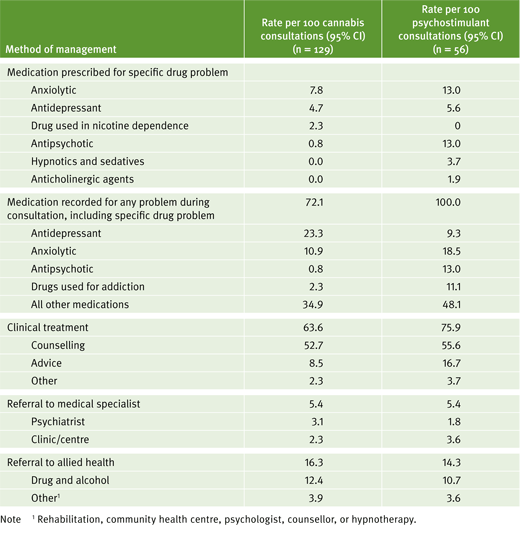Bulletin 2
The management of cannabis use in Australian general practice
Published March 2008
Anthony Arcuri, Amie Frewen, Jan Copeland, Christopher Harrison and Helena Britt
Key points
- Two of every 10,000 general practice consultations involve the management of cannabis-related problems, so there is an estimated minimum of 19,000 general practice consultations in Australia for this problem annually
- Compared with patients at other consultations, cannabis patients appear to be more likely to be male, to be aged between 15 and 44 years, to have a Health Care Card, and to be an Aboriginal or Torres Strait Islander
- Compared with psychostimulant consultations, cannabis consultations appear shorter on average, more likely to involve concurrent management of psychosis and anxiety, but less likely to generate prescription of antipsychotics
- There is a need to raise awareness of screening, assessment and brief interventions for cannabis-related problems among GPs to assist in early detection and more cost-effective treatment of cannabis-related problems in the community
Background
Cannabis use is infrequently managed by Australian general medical practitioners (GPs). In terms of illicit drug problems, however, it is second only to the management of heroin use, which mostly involves the prescription of opioid maintenance pharmacotherapy.1 In any given year, the majority of Australians (85%) visit a GP at least once.2 While the literature is replete with research exploring how alcohol,3 opiate,4 and tobacco5 use are managed by GPs, little is known about general practice management of cannabis use problems, particularly in Australia.
Data from the BEACH program
This bulletin explores data from the BEACH (Bettering the Evaluation and Care of Health) program, which is a continuous study of general practice activity across Australia.2 This study involves an ever changing random sample of approximately 1,000 GPs per year, who each provide details of 100 consecutive consultations. The BEACH data collected between April 2000 and March 2007 (n=689,000 encounters) demonstrates that there were 129 consultations with at least one recorded cannabis problem (referred to hereafter as 'cannabis consultations'). While this represents only 0.02% of all consultations, it equates to an estimated 19,000 cannabis consultations nationally per year. This is likely to be a significant underestimate, as there were 3,650 illicit drug problems managed in this period (1 per 200 encounters) in all, but the GP did not identify the specific drug in 2,841 (77.8%) of these.
Patient and GP characteristics
The 129 specified cannabis consultations involved 105 individual GPs. Table 1 shows the characteristics of the patients involved in these consultations, compared with those involved in all 689,000 general practice consultations during the same seven-year period (referred to hereafter as 'general consultations'). Males appear more highly represented among patients at cannabis consultations than in the total data set, as do those aged between 15 and 44 years and those with Health Care Cards. In contrast, patients at cannabis consultations appear to involve fewer patients from non-English-speaking backgrounds than average. None of the patients at cannabis encounters were over 64 years old.
Table 1
Characteristics of patients involved in cannabis and general consultations, 2000-2007

Compared with psychostimulant consultations, cannabis consultations involved a higher proportion of patients aged 25-44 years (47.2% compared with 27.1%) and patients aged 15 to 24 years (42.5% vs. 16.4%). This differing age profile is consistent with the younger age of cannabis users reported in the general population.6 No other differences regarding patient characteristics were found. Similarly, few differences were found in relation to GP characteristics, except that cannabis consultations appeared more likely than psychostimulant consultations to be reported by female GPs (38.8% vs. 14.8%) (results not tabled).
Characteristics of cannabis consultations
The characteristics of the cannabis consultations, against the psychostimulant consultations, are set out in Table 2. Cannabis consultations were less often new problems being managed by a medical practitioner for the first time, and were most commonly claimed for government reimbursement as standard consultations (usually less than 20 minutes). Although all patients were managed for cannabis-related problems, they often presented to the consultation with other complaints, including somatic and psychological (primarily depression and anxiety) problems. Other than the management of a cannabis problem, the GPs involved in these consultations most commonly managed a physical condition (primarily digestive), followed by a psychological problem (mainly depression, psychosis or anxiety) and, to a lesser extent, another illicit or a licit substance use problem (most commonly alcohol abuse). These problems are consistent with those reported previously in research exploring the health and psychological effects of cannabis use.7-9
Table 2
Characteristics of cannabis and psychostimulant consultations, 2000-2007

Compared with psychostimulant consultations, cannabis consultations appeared less often to be long consultations (i.e. usually between 20 and 40 minutes in duration). They appeared, however, more likely to involve the concurrent management of psychosis and anxiety, neither of which was managed concurrently in psychostimulant consultations. This is in contrast to previous research showing that hospital separations in Australia for cannabis-related psychotic episodes are less common than those for methamphetamine-related psychotic episodes.10
Management of cannabis consultations
Counselling was provided by GPs for almost two thirds of cannabis problems managed. Medications were not typically prescribed for cannabis problems but, when they were, such medications most commonly included anxiolytics and antidepressants, and, in one case, a medication used for nicotine dependence. Medications prescribed for any problem during cannabis consultations included antidepressants, anxiolytics and antipsychotics. GPs referred patients for treatment of the cannabis problem in more than one in five cases, most commonly to drug and alcohol services, followed by psychiatrists and specialist medical clinics or centres.
Table 3
Management of cannabis and psychostimulant consultations, 2000-2007

Compared with psychostimulant consultations, during cannabis consultations GPs appeared to less often prescribe an antipsychotic, either for the drug problem in particular, or for any problem that was managed during the consultation. This result appears inconsistent with the previous finding that cannabis consultations were more likely than psychostimulant consultations to involve the concurrent management of psychosis. This is a neglected research question worthy of further investigation.
Conclusions
This BEACH data, spanning over seven years, shows that, despite there being around 300,000 Australians using cannabis daily,6 the number managed for this problem by GPs is very small. This is in contrast to the increasing numbers presenting to specialist AOD treatment services.11
The majority of general practice consultations during which cannabis use is managed appear to involve patients who present for problems other than their cannabis use. It seems, therefore, that many cannabis consultations involve the opportunistic management of cannabis use problems. This finding highlights the need to assist GPs to recognise high-risk groups for screening, assessment and brief intervention. Such high-risk groups may include young males, those with respiratory problems, and those with depression, symptoms of psychosis, and other mental health problems.
Furthermore, considering that the majority of GPs appear to favour treatments such as counselling in the management of cannabis use problems, and that GPs often work within limited timeframes, it follows that brief motivational interviewing may provide an effective intervention for cannabis use problems managed in general practice settings. Indeed, motivational interviewing has demonstrated efficacy across a number of health areas beyond alcohol and other drug treatment (including diet, physical activity, pain management, diabetes control, sexual behaviour, and medical adherence),12 and thus may be a broadly-applicable and cost-effective intervention for GPs.
Although a small but significant minority of cannabis consultations in the current study involved the prescription of medications apparently intended to assist with cannabis withdrawal (including anxiolytics and antidepressants), the effectiveness of these or other medications for this purpose is poorly supported by research.13 Nonetheless, it is important to acknowledge that, as demonstrated in the current research, sometimes cannabis use problems are complex and are associated with the management of comorbidity, including psychosis, depression and anxiety. While many patients could be referred to the National Cannabis Information and Helpline (1800 30 40 50) for assistance, in more severe and complex cases prescription of psychiatric medications and referral to specialist psychiatric and/or drug and alcohol treatment services may be required.
Limitations
For the purposes of this Bulletin, no inferential statistics were reported; therefore, the conclusions must be viewed with some caution. These data, however, will be prepared for an international peer-reviewed journal where such statistics will be reported. An upcoming NCPIC e-Zine will direct you to this paper upon its publication.
- Degenhardt, L., Know, S., Barker, B., Britt, H., & Shakeshaft, A. (2005). The management of alcohol, tobacco and illicit drug use problems by general practitioners in Australia. Drug and Alcohol Review 24, 499-506.
- Britt, H., Miller, G.C., Charles, J., Bayram, C., Pan, Y., Henderson, J., Valenti, L., O'Halloran, J., Harrison, C., & Fahridin, S. (2008). General practice activity in Australia 2006-07. General Practice Series No. 21.Canberra: Australian Institute of Health and Welfare.
- Ballesteros, J., Duffy, J.C., Querejeta, I., Arino, J., & Gonzalez-Pinto, A. (2004). Efficacy of brief interventions for hazardous drinkers in primary care: Systematic review and meta-analyses. Alcoholism: Clinical and Experimental Research 28, 608-618.
- Strang, J., Sheridan, J., Hunt, C., Kerr, B., Gerada, C., & Pringle, M. (2005). The prescribing of methadone and other opioids to addicts: national survey of GPs in England and Wales. British Journal of General Practice 55, 444-451.
- Anderson, P. & Jane-Llopis, E. (2004). How can we increase the involvement of primary health care in the treatment of tobacco dependence? A meta-analysis. Addiction 99, 299-312.
- Australian Institute of Health and Welfare. (2005). 2004 National Drug Strategy Household Survey: Detailed Findings. Canberra: AIHW.
- Hall, W., Degenhardt, L. & Lynskey, M. (2001). The health and psychological effects of cannabis use. Monograph Series No. 44. 2nd ed. Canberra: Commonwealth Department of Health and Ageing.
- Copeland, J., Gerber, S. & Swift, W. (2006). Evidence-based answers to cannabis questions: a review of the literature. ANCD Research Paper 11. Canberra: Australian National Council on Drugs.
- McLaren, J. & Mattick, R.P. (2007). Cannabis use in Australia: Use, supply, harms, and responses. NDARC Monograph No. 57. Sydney: National Drug and Alcohol Research Centre.
- Degenhardt, L., Roxbrugh, A. & McKetin, R. (2007). Hospital separations for cannabis- and methamphetamine-related psychotic episodes in Australia. Medical Journal of Australia 186, 342-345.
- Australian Institute of Health and Welfare. (2007). Alcohol and other drug treatment services in Australia 2005-06: Report on the National Minimum Data Set. (Drug Treatment Series Number 7). Canberra: Australian Institute of Health and Welfare.
- Resnicow, K., DiIorio, C. & Soet, J.E. (2002). Motivational interviewing in medical and public health settings. In: Miller, W.R. & Rollnick, S. (eds). Motivational interviewing: preparing people for change. 2nd ed. New York: The Guilford Press, 251-269.
- Haney, M. (2005). The marijuana withdrawal syndrome: Diagnosis and treatment. Current Psychiatry Reports 7, 360-366.













































